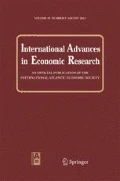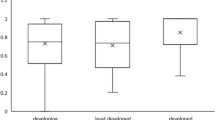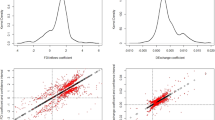Abstract
In this paper, we investigate the extent of monetary independence in a group of ten Asian countries: China, Malaysia, Japan, India, Indonesia, Philippines, Thailand, Korea, Singapore, and Hong Kong. While the traditional investigation has considered only the bivariate relationship between the home interest rate and the base rate, we employ both single-equation and vector autoregressive representations of the bivariate and the trivariate relationship including the desired (or optimal) interest rate. We find in most countries, that the ranking of monetary independence is relatively consistent across the models and methodologies although model specifications produce important differences for some countries such as Japan, Indonesia, and India. Trilemma suggests that a country cannot accomplish all three policy objectives: monetary independence, exchange rate stability, and free capital mobility. To increase monetary independence a country must choose between greater exchange rate flexibility or a lower degree of capital mobility. The fact that China and Malaysia, the two countries that are known to have imposed the strictest capital controls, consistently rank high in various scenarios while Hong Kong, which has maintained nearly the freest regime in capital markets, is lowest in monetary independence, indicates that perhaps capital controls may play a more important role than does exchange rate flexibility in securing independence in monetary policy making. On the other hand, countries that maintain greater exchange rate stability do not necessarily rank low, unless it is combined with greater capital mobility as in the case of Hong Kong.



Similar content being viewed by others
Notes
In simple terms, independent monetary policy means the ability of the monetary authority (the central bank) to set its policy interest rate for the purpose of domestic stabilization.
Aizenman et al. (2010) propose a measure similar to the regression coefficient. It is based on the correlation of the interest rates.
The Taylor rule, first proposed by John B. Taylor, is a monetary-policy rule that stipulates how much the central bank should change the nominal interest rate in response to changes in inflation, output, or other economic conditions.
This method of measuring monetary policy independence is innovative and in fact can be applied to a country that is a member of a monetary union and thus does not have its own policy interest rate. Most studies assume away that members of a monetary union completely lose monetary autonomy. What we are proposing here is consistent with observation that Germany and Austria seem to enjoy a greater freedom than does Greece or Spain even when all member countries in the Eurozone are subject to an identical interest rate set by the ECB.
Exceptions are China, and Philippines which have ending dates in November and March 2013 respectively. Singapore and Hong Kong have starting dates in August and June 1999 respectively. Indonesia starts in March 2001.
The NDF market in Asia emerged in the late 1990s after the Asian financial crisis when restrictions were placed on foreigners in the onshore forward market. The NDF market is a forward market where physical currencies are not exchanged and the transactions are settled in dollars. For an overview see Lipscomb (2005). There are no NDF markets for the Japanese yen, the Hong Kong dollar, or the Singapore dollar as cross-border capital flows are largely free from government restrictions. Further, Thailand does not have an NDF market, and the Malaysian time series is too short as the NDF market for their currencies was only developed recently.
For a similar purpose, Klein and Shambaugh (2015) incorporate inflation and GDP growth in their regressions.
Smoothing and the smoothing coefficient (δ) are defined as follows: \( {i}_t^{T\ smooth}=\delta\ {i}_{t-1}^{T\ smooth}+\left(1-\delta \right)\ {i}_t^{T\ actual} \). Clarida et al. (1998) report the parameter of different countries to lie between 0.87 and 0.95. The results remain similar if smoothing parameters in these ranges are used.
If it is ordered third, the overall effect is a slight decrease in the Taylor rule shock but not enough to change the overall interpretation of the results. There is almost no change at the three-month horizon, and there is only a few percentage point difference for most countries after the three-year mark.
The NDF market is an offshore market to trade and hedge in currencies of countries wherein there is no full convertibility (both the financial account and the current account). The NDF market traded currencies are the Indian Rupee, Chinese Yuan, Philippine Peso, Taiwan Dollar, and Korean Won. NDFs are distinct from deliverable forwards as the NDFs trade outside the countries of the corresponding currencies (McCauley et al. 2014). Theoretically, the NDF is supposed to equal the expected future exchange rate. If they are not equal then we know that the expected future exchange rate is pinned down by interest rate parity; if the NDF rate is different from that, there would be arbitrage opportunities by signing a forward contract and moving capital from one country to the other.
In the real world, capital controls are not the only reason covered interest parity will be violated; there may also be risk related reasons. First, if there is counterparty risk in the forward exchange market so that some of the contracts are not fulfilled, then this will discourage capital flows. If this risk is present, then it will influence the forward rate and then be part of computed capital controls. To overcome the risk, this paper uses data (where possible) from the less risky offshore NDF market rather than the onshore forward market. As the forward transactions in the NDF market are settled in dollars, there is less risk because the principle amounts do not move and currency does not need to be physically exchanges (Lipscomb 2005; Shamah 2008). A second type of risk is country investment risk. From the example, risk on investment in the home country will also discourage inflows. To solve this problem, we follow Shambaugh (2004) and assume that this risk stays constant over time. The overall results of this paper are determined by the movements in capital controls and interest rates over time; constant risks will not change the results.
The first row lists the standard deviation in the capital controls for each country, and the second is the standard deviation of ∆f, and the third is the standard deviation in the interest rate differential (iH − iB).
It is interesting to note that for many countries, the realized changes in the exchange rate were not anticipated as measured by the forward discount. The discrepancy is largest for Korea and Japan.
References
Aizenman, J., Chinn, M. D., & Ito, H. (2010). The emerging global financial architecture: Tracing and evaluating new patterns of the trilemma configuration. Journal of International Money and Finance, 29(4), 615–641.
Bloomberg (2015). Bloomberg terminal database. http://www.bloomberg.com/professional/solution/bloomberg-terminal/. Accessed 9 Feb. 2018.
Cheung, Y. W., Tam, D. C., & Yiu, M. S. (2008). Does the Chinese interest rate follow the US interest rate? International Journal of Finance and Economics, 13(1), 53–67.
Chinn, M., & Ito, H. (2008). A new measure of financial openness. Journal of Comparative Policy Analysis, 10(3), 309–322.
Clarida, R., Galı, J., & Gertler, M. (1998). Monetary policy rules in practice: Some international evidence. European Economic Review, 42(6), 1033–1067.
Clarida, R., Galí, J., & Gertler, M. (2000). Monetary policy rules and macroeconomic stability: Evidence and some theory. The Quarterly Journal of Economics, 115(1), 147–180.
Corsetti, G., Pesenti, P., & Roubini, N. (1999). What caused the Asian currency and financial crisis? Japan and the World Rconomy, 11(3), 305–373.
Dooley, M., & Israd, P. (1980). Capital controls, political risk, and deviations from interest-rate parity. The Journal of Political Economy, 88(2), 370–384.
Elliott, G., Rothenberg, T. J., & Stock, J. H. (1996). Efficient tests for an autoregressive unit root. Econometrica, 64(4), 813–836.
Frankel, J., Schmukler, S. L., & Serven, L. (2004). Global transmission of interest rates: Monetary independence and currency regime. Journal of International Money and Finance, 23(5), 701–733.
International Monetary Fund (2015). International Financial Statistics. http://www.imf.org/en/Data. Accessed 9 Feb. 2018.
Johansen, S. (1988). Statistical analysis of Cointegration vectors. Journal of Economic Dynamics and Control, 12(2–3), 231–254.
Jordà, Ò., Schularick, M., & Taylor, A. M. (2015). Betting the house. Journal of International Economics, 96, S2–S18.
Kim, C. J., & Lee, J. W. (2008). Exchange rate regime and monetary policy independence in East Asia. Pacific Economic Review, 13(2), 155–170.
Klein, M. W., & Shambaugh, J. C. (2015). Rounding the corners of the policy trilemma: Sources of monetary policy autonomy. American Economic Journal: Macroeconomics, 7(4), 33–66.
Kohli, R. (2012). India’s Experience in Navigating the Trilemma: Do Capital Controls Help? No. 23184. East Asian Bureau of Economic Research.
Lipscomb, Laura (2005). “An overview of non-deliverable foreign exchange forward markets.” Federal Reserve Bank of New York. Available at: https://www.bis.org/publ/cgfs22fedny5.pdf
Ma, G., & McCauley, R. (2008). Efficacy of China’s capital controls: Evidence from price and flow data. Pacific Economic Review, 13, 104–123.
Ma, G., Ho, C., McCauley, R. (2004) “The markets for non-deliverable forwards in Asian currencies.” BIS Quarterly Review, June 2004, pp. 81–94. Available at: https://www.bis.org/publ/qtrpdf/r_qt0406g.pdf
McCauley, R., Chang Shu and Guonan Ma (2014). “Non-deliverable forwards: 2013 and beyond.” BIS Quarterly Review, March, 75–88. Available at: https://www.bis.org/publ/qtrpdf/r_qt1403h.htm
Ng, S., & Perron, P. (2001). LAG length selection and the construction of unit root tests with good size and power. Econometrica, 69(6), 1519–1554.
Obstfeld, M., Shambaugh, J. C., & Taylor, A. M. (2005). The trilemma in history: Tradeoffs among exchange rates, monetary policies, and capital mobility. The Review of Economics and Statistics, 87(3), 423–438.
Rey, H (2013). “Dilemma not trilemma: The global financial cycle and monetary policy independence.” In Global dimensions of unconventional monetary policy, proceedings of the Federal Reserve Bank of Kansas City Jackson Hall symposium, pp 285–333.
Shamah, Shani (2008). Chapter 65. An introduction to foreign exchange derivatives. In: Frank J (ed) Handbook of Finance: Financial Markets and Instruments. 687–700.
Shambaugh, J. C. (2004). The effect of fixed exchange rates on monetary policy. The Quarterly Journal of Economics, 119, 301–352.
Straetmans, S., Versteeg, R., & Wolff, C. (2013). Are capital controls in the foreign exchange market effective? Journal of International Money and Finance, 35, 36–53.
Taylor, John B. (1993). "Discretion Versus Policy Rules in Practice." Carnegie-Rochester conference series on public policy. Vol. 39. North-Holland.
Author information
Authors and Affiliations
Corresponding author
Additional information
This paper has been written with a generous support from The A P J Kalam India Studies Research Program. We have benefitted from very useful and constructive comments from two referees.
Rights and permissions
About this article
Cite this article
Nanovsky, S., Kim, Y. International Capital Movement and Monetary Independence in Asia. Int Adv Econ Res 24, 179–198 (2018). https://doi.org/10.1007/s11294-018-9682-z
Published:
Issue Date:
DOI: https://doi.org/10.1007/s11294-018-9682-z




